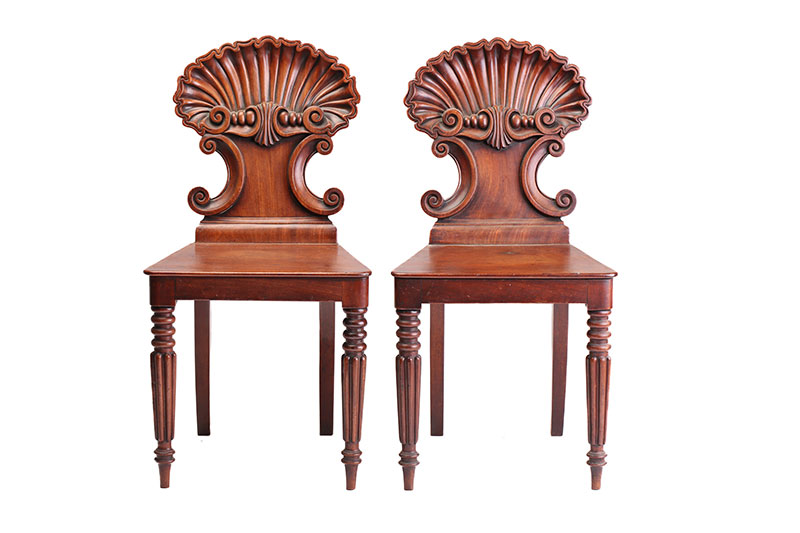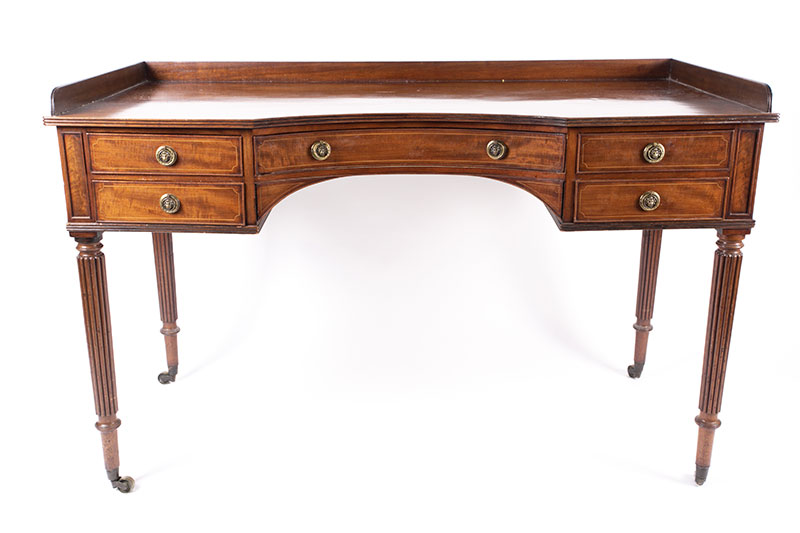How do I identify Gillows furniture?
Exceptional craftsmanship and classic elegance ensure that Gillows furniture is highly sought after
17/06/2024
Originally founded by Robert Gillow in 1728/1729 in Lancaster, a second branch of Gillows was established in London in 1769. These two workshops would produce their own distinctive styles: the London branch typically reflecting the most up to date tastes, while the Lancaster workshop followed slightly more conservative trends. Gillows remained in family ownership until the 19th century, merging with Warings in 1897 to become Waring and Gillows. They continued to produce quality furniture well into the 20th century. Not only did they supply furniture to nobility and gentry throughout the United Kingdom, but they also exported their creations to Europe, North and South America, Australia, New Zealand, and the Caribbean.
A pair of George IV mahogany shell backed hall chairs, possibly by Gillows of Lancaster
Exceptional craftsmanship and classic elegance ensure that Gillows furniture is highly sought after by collectors and antique enthusiasts alike. As one of the leading English furniture makers of the 18th and 19th centuries, and with contributions from ten family members over several generations, identifying genuine Gillows pieces is certainly a valuable skill.
Key characteristics to look for when identifying Gillows furniture include the following…
Maker's Mark: Authentic Gillows furniture often features the maker's mark in the form of a stamp, pencil signature, printed label, or brass plate. These can be located under tabletops, on the back of legs and bases, as well as to the edges or linings of drawers. The earliest examples were in the form of a printed label “Gillow and Taylor”, but these are incredibly rare to find as they often fell off or were ripped. From the 1780s a “Gillows Lancaster” stamp was used until changing to “Gillow” around the mid-1800s. An “L” mark together with a serial number could also be seen in the 1860s. Late Victorian pieces were stamped “Gillow & Co” and then “Waring & Gillow”. Sadly, a large portion of Gillows furniture was not marked, which means the association has to be determined based on the design, style, and materials.
A Regency Gillows of Lancaster mahogany kneehole library/ dressing table
Construction Techniques: Gillows furniture is known for its superior craftsmanship and ingenuity. From mortise-and-tenon joints to the most sophisticated locks of the era, a Gillows piece of furniture will demonstrate exceptional attention to detail in its creation.
Materials: Gillows favoured high-quality exotic woods such as mahogany, rosewood, walnut, birch, and oak, which were expertly selected and finished. They also used unusual veneers and painted designs such as Japanning (a kind of enamel-like varnish).
Design Aesthetics: Gillows pieces were flawlessly designed, often exhibiting classic Georgian and Regency styles, with clean lines, elegant proportions, and minimal ornamentation. Throughout the evolution of the firm, a typical house style can be observed by the keen eye.
Provenance: A documented history and record of ownership can help confirm the authenticity of a Gillows piece – any relevant invoice / proof of purchase will certainly be extremely useful.
A George IV birds eye maple rectangular writing table by Gillows of Lancaster
Research: There are a number of reference books on the market that could provide supporting evidence as to the origins of a piece of Gillows furniture. Indeed, though incomplete, the Gillows archives are the largest and most comprehensive cabinetmaker’s records in the world to have survived.
While understanding these identifying features will undoubtably afford enthusiasts with a greater confidence to associate a piece with the name Gillows, consulting with an expert valuer or dealer is the most conclusive way to determine authenticity and origin. Our team at Dawsons would be happy to provide sound advice.
Read More
Do you have any Gillows furniture that you are considering selling?
With a global audience of over 10 million active bidders, Dawsons can secure the highest price for you.
Get in touch with an expert valuer for confidential sales advice, we would be delighted to help:


